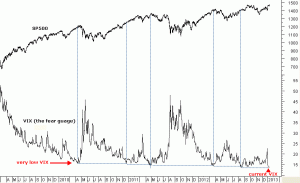Our Longer Term and Shorter Term analysis continues to be positive and supportive for the equity market. But our Market Sentiment readings suggest that a high number of investors have turned from Bears to Bulls recently and if this continues it may become a problem. The market will often “overheat” when a majority of investors suddenly become actively bullish and we may be seeing the beginnings of this at the moment.
As an example we would cite an indicator often talked about in the media called the VIX. This is a volatility measure based on traded options data and is usually called the “fear gauge”. Knowing how to interpret this indicator is a key factor in assessing market sentiment. This is used as a “Contrarian Indicator”, such that when the Indicator (acting as a fear gauge) is very high, Stockmarkets will often have suffered significant losses. In contrast, when fear is low this often indicates that there is excessive optimism, usually following a stockmarket rally. When the VIX hits extreme readings this usually indicates the market has been over-stretched and a correction usually follows. Market rallies often follow periods when the fear of investing is extremely high, whilst sharp corrections can often follow periods when the fear of investing is very low, indicating that the public have become complacent. Currently the VIX is very low relative to readings over the last few years. On Friday it closed at its lowest level since 2007. This is a concern.
Another general market indicator that we find useful is to calculate the percentage of stocks within a market or index that are currently priced above their 50 day moving average (of price). So for instance, a reading of 68 for the UK Allshare would mean that 68% of the stocks within that index are trading above their 50day average price. If that overall percentage number is greater than 50 it usually indicates a healthy, positive market. However, if that number climbs above 80 it will often indicate a market that is overheating and ready for a correction. Currently that is where we are with the UK Allshare number at 87% and New York Nyse at 89%.
Mindful of this and looking at other readings we would say that the market is overbought, with equity investors, if not excessively enthusiastic, then certainly showing a high level of complacency. None of this fires off immediate signals for us but if history is a guide we should be a little more cautious right now than would otherwise be the case.
